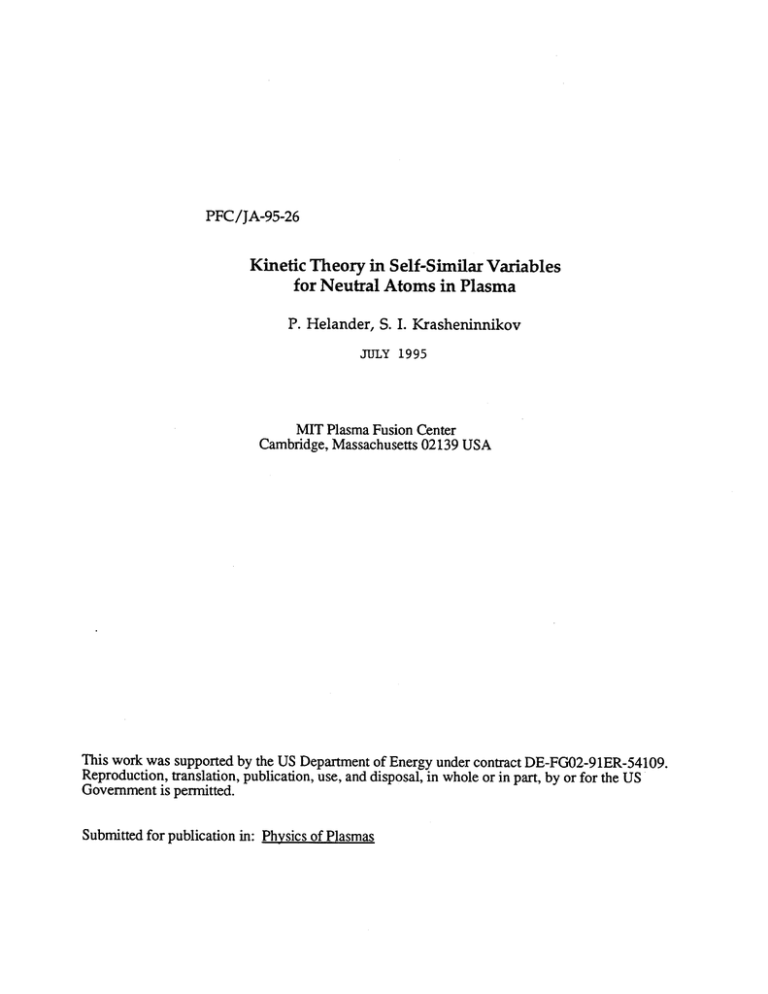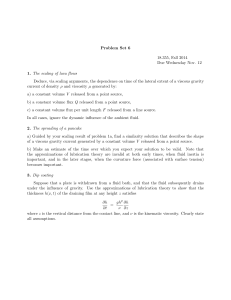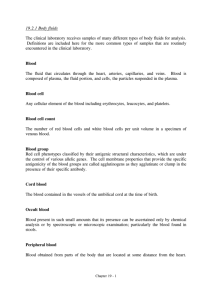Kinetic Theory in Self-Similar Variables
advertisement

PFC/JA-95-26
Kinetic Theory in Self-Similar Variables
for Neutral Atoms in Plasma
P. Helander, S. I. Krasheninnikov
JULY 1995
MIT Plasma Fusion Center
Cambridge, Massachusetts 02139 USA
This work was supported by the US Department of Energy under contract DE-FG02-91ER-54109.
Reproduction, translation, publication, use, and disposal, in whole or in part, by or for the US
Government is permitted.
Submitted for publication in: Physics of Plasmas
Kinetic theory in self-similar variables for
neutral atoms in plasma
P. Helander and S.I. Krasheninnikovl)
PlasmaFusion Center
MassachusettsInstitute of Technology
167 Albany Street, Cambridge,MA 02139
Abstract
The kinetics of neutral atoms in a plasma undergoing charge-exchange, ionization, and
recombination is considered. It is shown that if the mean-free path divided by the
macroscopic scale length is constant, it is possible to introduce self-similar variables in the
Boltzmann equation for the neutral particles. This equation is then solved analytically, and
the nonlocal transport of heat and particles is calculated. Since the mean-free path increases
with increasing energy, a one-sided, high-energy tail is formed in the neutral distribution
function. This tail may contribute significantly to the heat and particle fluxes. When this is
the case, the fluid approximation of these quantities breaks down at arbitrarily short meanfree paths.
PACS numbers: 52.25.Dg, 51.10.+y, 52.40.Hf
1) Permanent address: Kurchatov Institute of Atomic Energy, Moscow, Russia.
-1-
1. INTRODUCTION
Neutral atoms are abundant in any sufficiently cool and dense plasma, and play an
important role in the tokamak edge plasma, especially in the divertor. In a hydrogen
plasma, neutral atoms interact with the ions mainly through charge exchange (CX),
ionization, and recombination. The dynamics of the neutrals is often (e.g., in plasma edge
codes) described by fluid equations taking these processes into account. Neutral fluid
equations can be derived rigorously by a systematic (Chapman-Enskog) expansion in
ym/L, the mean-free path of the neutral particles, , divided by the macroscopic length
scale, L.1- 3 This parameter is, however, not always small in practice. For instance, the
tokamak scrape-off layer (SOL) is generally only about a centimeter wide, which is usually
comparable to the neutral mean-free path. It is therefore desirable to determine exactly when
fluid equations are valid. A kinetic treatment of the neutrals is then necessary, and has been
carried out in, e.g., Refs. 4-7, where the one-dimensional neutral kinetic equation was
solved by means of the Wiener-Hopf technique or by expansion in singular eigenfunctions.
These techniques are elegant, though laborious, but suffer from the shortcoming that they
are only able to treat a nearly isothermal plasma; the temperature must not vary significantly
over a CX mean-free path, a condition clearly not satisfied in a typical tokamak SOL. In
addition, it must be assumed that the CX cross section a be exactly inversely proportional
to the relative velocity vrel of the atom and ion participating the in the CX reaction. This
assumption was also made in Ref. 8, where the authors were able to treat the case of strong
temperature variation under an additional simplifying assumption when calculating the
density.
In the present paper, we solve the neutral kinetic equation in an entirely different way,
allowing for strong temperature variation as well as for accurate dependence of a on vel,
but neglecting the role played by boundary conditions. The solution is possible if the ratio y
-2-
of the mean-free path to the temperature length scale is constant throughout the plasma. As
shown in Sec. II, it then becomes possible to introduce self-similar variables which reduce
the dimensionality of the equation. 9 If the conventional assumption O~l/vreI is made, it is
then relatively easy to find the neutral distribution function analytically. This makes it
possible to establish bounds on the applicability of fluid equations. Interestingly, it turns
out that the condition y<<1 alone does not ensure that the fluid approximation is valid; an
additional constraint also applies. In other words, the Chapman-Enskog expansion fails in
certain cases even for arbitrarily small y! The reason for this is the formation of a tail in the
neutral distribution causing it to depart significantly from a Maxwellian at high energies and
leading to strongly increased transport. A similar phenomenon occurs for electron heat
transport in sufficiently steep temperature profiles. 9 The shape of the tail is expected to be
sensitive to the CX cross section a. The use of a more exact expression for a than
previously employed is therefore investigated in Sec. III. It is shown that although the full
kinetic equation is not amenable to analytic solution in this case, it is still possible to obtain
the relative distribution of high-energy neutrals. These particles not only contribute
essentially to high moments (like the heat flux) of the distribution function, but are also of
particular importance for wall sputtering. Finally, in Sec. IV we summarize our
conclusions.
II. SELF-SIMILAR VARIABLES IN A SIMPLE CX MODEL
1. The kinetic equation in self-similar variables
The Boltzmann equation for neutral atoms, interacting with a background plasma through
CX, ionization, and recombination is in steady state1-3
-3-
v;V/fn(v)=
o(Iv - v'I)v - v(fi(v)f n(v)- fn(v)fi(v')1v'
-
Kznif a(v)+ vrfi(v), (1)
where f, and fi denote the neutral and ion distribution functions, respectively. The first
term on the right-hand side describes CX, the second one ionization with the rate constant
Kz, and the third term represents a source of neutrals through recombination of ions and
electrons with the frequency vr. As in earlier works, we have neglected neutral-neutral
collisions and other processes which may be important in very weakly ionized plasmas. We
have also restricted our attention to one spatial dimension in the direction of the gradients of
the background plasma; v// denotes the component of the velocity v in this direction.
The CX cross section is usually",2,4- 7 taken to be inversely proportional to |v - V|, since
the CX operator is then greatly simplified. Indeed, if K=o( Iv - V'|)|v - V'I is the CX rate
constant, Eq. (1) then gives
nK +v
a-f n
V//
r
ay
ni (K,+KZ)
(2)
f1,
where n and ni are the neutral and ion densities, respectively, and a/ay=[ni(K,+Kz)]-1V//.
Eqs. (1) and (2) contain several length scales, namely, the mean-free paths with respect to
the atomic processes, and the macroscopic length scales associated with the ion distribution
function, most importantly those of density and temperature variation. If the ratio of the
mean-free paths to the macroscopic lengths is constant throughout the plasma, it is natural
to assume that fn have self-similar structure. 9 Let us therefore seek solutions of the form
f n(y, v)
=
N
a
(3)
F(u),
Ta(y)
-4-
where
is the velocity normalized to the thermal speed at the temperature T(y),
u=v/vT
V-R(2T/M)1/2, a is a free parameter, and N is a normalization constant chosen such that
fF(u)d 3 u = 1.
(4)
The neutral density then becomes
n(y)
=
Nv(y)
Ta(y)
(5)
T3/2-a
Eq. (2) now takes the form
( u aF
YXu --- +aF -F=-f,
(6)
2 au
where xmu///u, f
ni 3
f
Kx +vr jn
aK,+
(7)
,
KX+K z
and
dlnT
Y =VTr
d~T
dy
______
_
V//
ni(K,+Kz)
nT
%X
L
(8)
is the ratio of the mean-free path AX with respect to CX and ionization to the temperature
length scale L. For definiteness we shall assume that y> 0 so that the temperature increases
with y. On the other hand, note that the density of neutrals (5) decreases with y (if x>3/2),
whereas their temperature follows that of the ions due to the coupling through CX. In the
-5-
following, the solutions of the kinetic equation we obtain thus describe the penetration of
neutrals atoms into an increasingly hotter plasma.
If 3 and y are both constant, and if f depends only on u, then the neutral distribution
function is self-similar in y and can be obtained by solving the simple ordinary differential
equation (6). 10 The requirement that y be constant imposes a restriction on the allowed
background plasma profiles; the density and ion temperature profiles are coupled through
Eq. (8), but one of these profiles is still completely arbitrary. The parameter
P is constant if
Kz and vr/n are constant. These quantities are dependent on the electron temperature, and
their constancy therefore imposes no additional constraint on T(y). The ionization rate
constant Kz is a slowly varying function of the electron temperature above about 20 eV. In
order for the quantity vr/n to be constant, the recombination rate must decrease with
increasing y, i.e., in the direction of increasing temperature, which is indeed the case.
Thus, although the requirement that P,y=const., unfortunately, restricts the applicability of
the self-similar solutions somewhat, it does not in any way impose unphysical constraints.
2. The distribution function
Let us now proceed to study the solution to Eq. (6), which is
2P
F(u)=
f
yu11 P
x I(!
2(s -1)l
S
ds0
yu//
0 D(9)
2(s -l)1 ds
u_
- _2[
f- k!exp[
-u//]S,
u// <0
In addition, there are homogeneous solutions for u//>O proportional to exp[-2/(yu//)]/u 2 a,
which are disregarded as being unphysical (representing a tail of hot neutrals originating
-6-
from the cold plasma region y--oo). If the mean-free path is short, y-.0, the neutral
distribution (9) becomes proportional to the ion distribution,
lim F(u) =f(u),
(10)
and not necessarily to a Maxwellian since there is nothing that randomizes particle motion
in the kinetic equation (1). Usually, however, we expect the ion distribution to be
Maxwellian, f(u) = a3 2 exp(-u 2 ), which we, for simplicity, take to be at rest. With this
choice for the ion distribution, let us consider the neutral distribution over parallel
velocities. From Eq. (9) we have
2
r2(s-1)
1
us-2
2
F//(u//) =F(U) d2u
u/
1
ds
,
;
0
(11)
000
I 2(s -1)
2P
U/2/
ds
The first of these expressions has the following asymptotic form
I
F;/)
exp
/)
,
S 2L1 _(a - 1)yu; + YU/
u/ 1>0
(12)
-
2
in the limit 1/yu// +u//
-
a >>1, which is approached for both small and large u//.If the
mean-free path is short, this inequality is satisfied for all u//>0. In this case, Eq. (12) is a
good approximation for the entire u//>0 part of the distribution function, providing kinetic
information to the first order in y beyond the fluid limit. In particular, we note that F//(u//)
peaks for
-7-
(13)
aF////u/ / = 0 =>- u/;/~-y (a - 1)/2,
and decays much faster than a Maxwellian at high velocities u//>y- 1/3 . The reason for this
tail depletion is that particles in this far end of the distribution originate from colder regions
(small y). Conversely, for particles traveling in the negative direction (u//<O), the tail is
enhanced as compared with a Maxwellian. For -u//>y-113>>1, the asymptotic form of Eq.
(11) is
7/;/)
-
20
21/ 3 u2a-2
1i2 (2 a-1)
3
exp(2)73
2
yu7/)
(14)
2 2
which at large negative velocities approaches a power-law tail, F//(u//)ocu//- a- , of
particles originating from the hot region y-oo. Note that the tail is exponentially small in y,
and thus cannot be found by means of any expansion in this parameter, even if indeed
y<<l. Fig. 1 shows a graph of a numerical evaluation of Eq. (11) along with the
asymptotic forms (12) and (14). The asymmetric nature of the distribution function is
evident with a peak at u//>O, a rapid decay for large positive u//, and an elongated tail for
negative u//.
3. Fluxes
Let us now evaluate the particle flux and the heat flux associated with the neutral
distribution function (9). The former,
j//
If
(15)
nY /d V = nvTf F/;u, / du//
-8-
can be obtained directly from the self-similar kinetic equation (6) by integrating it over
velocity space, giving
j)
(16)
nV.T,
regardless of the ion distribution. However, it should be noted that only two of the three
parameters a, P and y are independent since Eq. (4) imposes a constraint on the solution
(9). If, for instance, the ion distribution is Maxwellian, Eqs. (4) and (9) imply
P(Y a )
2 j
du,' j
0
0
2 s -1|
)
s
1
which determines one of the three parameters, and the particle flux (16), as a function of
2
the two other parameters. For y<<l, P(y,a)~1+(a-2)(a-5/2)y /2, so the short-mean-free-
path limit of Eq. (16) is
_ y(a -5/2)nV
2
(18)
in agreement with fluid theory. Indeed, one recovers exactly this result by using Eqs. (5)
and (8) in the momentum equation
-V;;(nT)+ Mni(K. +Kz)j, 1
=
(19)
0
from Ref. 2.
-9-
Going beyond the fluid approximation, we can obtain the particle flux from Eq. (16) by
evaluating the integrals (17) numerically. Fig. 2 shows the flux normalized to the fluid
result (18) close to the singularity at a=2 in Eq. (16). The fluid approxiamation is,
apparently, not bad unless a is very close to 2, or the mean-free path is very long. When
a:2, the integral (15) diverges, and the flux becomes infinite. The reason for this is the
presence of the high-energy tail ~u/-2a-2, cf. Eq. (14). Unless the neutral density (5) falls
off quickly enough with y (i.e., a is sufficiently large), the tail is large enough to dominate
the flux, no matter how short the mean-free path is. If a=5/2 and y-+0, the flow of hot
neutrals from y-co exactly balances the positive particle flux of thermal ones. At large a,
the neutral density gradient becomes increasingly-steeper [cf. Eq. (5)], and the mean-free
path is not adequately measured by y, which relates only to the temperature gradient. For a
comparison of the particle flux with the fluid approximation in this regime, it is therefore
more appropriate to plot the ratio as a function of ya, as has been done in Fig. 3. The fluid
result is quite good, even for moderate mean-free paths, ya<1, unless a becomes very
large. In this limit (a-oo, but ya remaining finite), Eq. (17) implies that
P->0,
and the
ratio of the actual flux (16) to fluid result (18) approaches 2/(ya) 2 (the dotted line). The
approach to this asymptote is slow for small values of ya; a detailed analysis shows that it
occurs if a>(ya)-2 . Physically, the limit P--+O means that ionization dominates over CX
and recombination [cf. Eq. (7)], in which case the fluid limit cannot be realized since the
neutral-ion coupling through CX disappears.
This effect of the tail is, of course, even more pronounced in higher moments of the
distribution, as in the heat flux
q
ffn M v/ d3v = vTnTfFu 2 u// du,1 .
Substituting the solution (9) into (20) gives
-10-
(20)
= VnT fT
q
+ u2 )du/
(21)
x1
r
2(s -)]
x
(//ex[
y//
[2(1-s)l
ds
ds
f//(- u/;)exp[ yu/s
2
if the ion distribution can be written as f(u)= ij(u±)i//(u//), where ff±(u1 )d u±=1,
and x is the normalized perpendicular temperature
T
1J
(22)
(u)u1d2 u1 .
In the limit y-+oO, Eq. (21) reduces to
2uf//i//(u//)du// +y(2a-7)
T +//~Un
T+U 2 )U2f/(U/)dU/,
(23)
and for Maxwellian ions we obtain
q/
0
(24)
a -7/2) PVTnT,
4
in agreement with Eq. (67) of Ref. 2, according to which the conductive part of the heat
flux is
qc
(25)
V/ /T.
5nT
-d
Scond2Mnj (K, + K z
-11-
Using Eq. (8) for V//T and adding the convective heat flux corresponding to the flow (18)
gives precisely (24). Apparently, when a=7/2, the convective and conductive parts of the
heat flux cancel exactly in the fluid limit. If y is finite, the heat flux can be obtained by
evaluating Eq. (21) numerically. Choosing the ions to be Maxwellian, we see from Fig. 4
that the fluid result is not bad unless a is very close to the value where the tail particles
dominate, which now occurs at a=3. If a53, the second integral in Eq. (21) diverges as
the flux associated with the tail becomes infinite, again regardless of the mean-free path.
For a<4, the heat flux increases more slowly than linearly for large y. This can be
understood by taking the limit y-+o in Eq. (21), which for Maxwellian ions becomes
qY
2a-7
v2nTp
(a - 3/2)F(a - 5/2)T(2a - 6)
26 -6 ,1/2
(26)
The curves in Fig. 4 have a<4 and therefore decrease for large y. For large values of a,
Fig. 5 shows that the fluid result is again quite good unless a or the normalized mean-free
path ya becomes very large.
III. A MORE EXACT MODEL FOR CX
The high-energy tail discussed in the previous section consists of fast neutrals that have
escaped from the hot region y-+oo. This is possible since the mean-free path increases with
energy. Indeed, the assumption that aoc1/vrel made in the previous section and in most
earlier worksl,2,4- 7 gives a mean free path that increases linearly with velocity,
X=<vrei>vre=Kxvrei. In reality, a depends much more weakly on the velocity. In the
present section, we employ the much more exact model
(27)
a(vrei)= Yov'1,
-12-
where 6-0.84, shown in Fig. 6 along with the exact cross section taken from Ref. 11. The
conventional model is recovered by letting 6=0, and the approximation o=constant, used
for deriving fluid equations in Ref. 3, is obtained in the limit 6->1.
With the CX cross section (27), the kinetic equation (1) again has self-similar solutions if
simplifying assumptions are made about the ionization and recombination rates. Indeed, if
the ionization rate constant is
(28)
Kz(T) = VTO( T),
and the quantities , yad(InT)/dym[nio(vT)]-1V//(1nT) and
Vr
(29)
nnivTCr(vT)
are constant, we can make the self-similar Ansatz (3) and write Eq. (1) as
yxu
+FaF f
-u
f[(u)F(u')-i(u')F(u)u' -F+
pi.
(30)
It is clear that if f only depends on u, then so does the solution F to Eq. (30), i.e., it has
self-similar structure.
Eq. (30) is still too difficult to solve analytically because of the complicated form of the CX
operator. However, if we only consider tail particles, we may take u>>u' in the CX
operator, simplifying Eq. (30) to
-
13
-
(31)
+ t)F = -(u6 + p)f.
aF -(u
Y+
For particles traveling in the negative (x<O) direction, the solution to this equation is
F(u)=-
2(a-1)
+ u'- -u
-
(u' +p exp r
1)(U')d'
(32)
0
for 0<6<1, and
F(u)= -
2(a-1)-IYX(u'+pexp
ku
YXu{ku!
0
x
k-
-[
u')du'
-(33)
for 6=1. In these integrals, the direction of u' is to be held constant in the integration; only
its magnitude u' varies. One important difference between Eqs. (32) and (33) is seen
2
immediately: If 6<1, the distribution function has a tail proportional to u- a, as in the
previous section, whereas if 6=1, the tail is extremely small for short mean-free paths,
2
being proportional to only u-(2a-/YX), where the exponent is a-1/YX>>l. The underlying
physical reason for this is that if 6=1, the CX cross section and therefore also the mean-free
path are independent of velocity. Consequently, fast neutral are no more able than slow
ones to escape from the hot region y->oo.
Since actually 6-0.84, an sizable tail arises consisting of fast neutrals traveling in the
negative direction. The asymptotic form of the distribution function (32) is
u)~
F()%
2e-1[Q! + p)
2a
exp[Q(u, u),
-14-
(34)
where
Q(1 U) a2
Q~,)
-
--- + uU* -1-6
yx u, U
2
-u,(35)
and u, is defined as the value of u' where the exponent in Eq. (32) peaks,
U
~1+
(yX)Y(3-6)
[
3- 6
(
)(36)
In the far tail region, u>>u,>>1, the distribution (34) has the form F(uX)=Fo(X)/u 2 a.
Again, the height of the tail is non-expandable in y, and the moments corresponding to the
particle flux (15) or the heat flux (20) still diverge for as52 and acs3, respectively. The
effect of the tail on the fluxes is thus qualitatively the same as in the simpler model 6=0
considered in the previous section. The shape of the tail is also important for wall
sputtering, which in some cases can be dominated by fast neutrals escaping from the hot
plasma and reaching the wall. Our analysis shows that the tail should be expected to be
strongly enhanced over an Maxwellian, as was also pointed out in Ref. 8.
IV. CONCLUSIONS
The results of this paper can be summarized as follows:
1. If the density and temperature gradients are constant as measured in neutral mean-free
paths, there are self-similar solutions to the Boltzmann equation for neutral atoms in a
plasma undergoing CX, ionization, and recombination. These solutions describe neutrals
penetrating into a hot plasma.
-
15-
2. If the usual assumption is made that the CX cross section is inversely proportional to the
relative velocity, it is possible to find the exact self-similar solutions analytically for
arbitrary mean-free paths. The neutral distribution function is markedly asymmetric with a
peak at positive velocities, and a power-law tail at large negative velocities. In a more
accurate model with the CX cross section decreasing as a (small) power of the relative
velocity, a(vrei) - oevj
1,
the tail persists and has qualitatively the same structure. It is
non-expandable in y, and therefore eludes any short-mean-free-path expansion.
3. The self-similar solutions can be used to test. the accuracy of neutral fluid models,
14
currently in use, e.g., in plasma edge codes, 12 ,13 and to benchmark Monte Carlo codes.
Most importantly, the kinetic and fluid predictions for the fluxes of heat and particles can be
compared. This comparison shows that the requirement that the mean-free path be short is
not sufficient for the fluid results to be correct. In addition, the parameter a in Eq. (5),
which is determined by the mean-free path and the rate constants of the atomic processes,
must be large enough. For instance, if a53 the expression (21) for the heat flux diverges
because of the power-law tail in the distribution function. Of course, the heat flux does not
actually become infinite, since the tail is limited by the circumstance that the extent of the
plasma, as well as its temperature, is bounded. Some cut-off therefore appears in the
diverging integral. The point is, however, that the heat flux can become extremely large
before this happens; since there are usually big temperature differences in the plasma,
Tmax>>Tmin,the cut-off appears only at very high energy. The mean-free path must
therefore be exceedingly small to ensure the correctness of the fluid approximation in this
case. On the other hand, if the tail does not the dominate the fluxes, or if Tmax/Tmin is
moderate so the tail does not exist, fluid results appear to be quite accurate even for
relatively large values (ya<1) of the mean-free path.
- 16-
ACKNOWLEDGMENTS
We are grateful to Peter Catto for fruitful and inspiring discussions, and to Dieter Sigmar
for his support and encouragement. This work was funded by U.S. Department of Energy
Grant no. DE-FG02-91ER-54109, by the European Union under an association contract
between Euratom and Sweden, and by a fellowship to one of the authors (PH) from the
Swedish Institute.
REFERENCES
1R.D.
Hazeltine, M.D. Calvin, P.M. Valanju and E.R. Solano, Nucl. Fusion 32, 3
(1992).
2p.J. Catto, Phys. Plasmas 1, 1936.
3P. Helander, S.I. Krasheninnikov, and P.J. Catto, Phys. Plasmas 1, 3174.
4 J.W.
Connor, Plasma Phys. 19, 853 (1977).
5 T.F.
Volkov and Yu.L. Igitkhanov, Sov. J. Plasma Phys. 3, 668 (1977).
61.p. Stakhanov and Yu.L. Igitkhanov, Sov. J. Plasma Phys. 4, 559 (1978).
7 N.B.
Marushchenko, V.N. Pyatov, and Yu.A. Turkin, Sov. J. Plasma Phys. 9, 717
(1983).
8 M.B.
Tendler and 0. Agren, Phys. Fluids 25, 1040 (1982).
9S.I. Krasheninnikov, Sov. Phys. JETP 67, 2483 (1988).
10 1t is
actually enough that the parallel velocity dependence is of this form, since the kinetic
can also be solved after integrating it over perpendicular velocities.
1 1R.K.
Janev, W.D. Langer, K. Evans, and D.E. Post, Elementary Processes in
Hydrogen-HeliumPlasmas (Springer-Verlag, Berlin, 1987), pp. 128-129.
-
17-
12S.I.
Krasheninnikov, A.S. Kukushkin, and V.A. Pozharov, 11th International
Conference on Plasma Physics and ControlledNuclearFusion Research (IA EA, Vienna,
1987). Vol. 2, p. 177.
13 D.A.
Knoll, P.R. McHugh, S.I. Krasheninnikov, and D.J. Sigmar, Simulation of dense
recombining divertorplasmas with a Navier-Stokes neutral transportmodel, submitted to
Phys. Plasmas.
14 D. Stotler and C. Karney, Contrib. Plasma Phys. 34,392 (1994).
-
18-
FIGURE CAPTIONS
Fig. 1. The neutral distribution function (11) over parallel velocity divided by P (bold line),
and its asymptotic forms from Eqs. (12) and (14) (dotted lines). The former [Eq. (12)]
almost coincides with the bold line. a=4, y=0.2.
Fig. 2. The neutral particle flux (16) normalized to that in the fluid limit (18) vs y for a
ranging from 2.03 to 2.2.
Fig. 3. The neutral particle flux (16) normalized to-that in the fluid limit (18) vs ya for large
a (bold lines), and the asymptotic limit a-+oo (dashed line).
Fig. 4. The neutral heat flux (23) with Maxwellian ions normalized to that in the fluid limit
(24) vs y for a from 3.03 to 3.2.
Fig. 5. The neutral heat flux (23) with Maxwellian ions normalized to that in the fluid limit
(18) vs ya.
Fig. 6. The CX cross section 11 a (bold line) for hydrogen vs relative kinetic energy, and
the approximation (27) (dotted line).
-
19-
1
0.01
0.0001
1.10
1.10
-6
-8
-10
-5
0
u
1
-20-
I
5
10
j//
7~y
(a, -+0)
4
oc=2.03
3
ac=2.05
2
(x=2.1I
1
oc=2.2
0.1
10
Y
-21-
j// (cXY)
j/
2.5
2
(oc
0),
,
S.
-5
1.5
0.5
011
10
-22-
.q9//
y)
q //(cc,y -+- 0)
4
-
3
a
*=3.03
ac=3.05
2
oc=3.1I
1
ac=3.2
0
0.1
0.2
0.5
1
2
5
7
p1il4. Lj
-23-
q//(c7)
q//(OC,7 -+ 0)
4
3.5
3
2.5
a=10
2
o=6
c(=5
1.5
1
oc=4
0.5
0
.
,
.
.
.
p
p
0.1
p
1
F, . -
-24-
p
p
p
p
p
e
S
P
10
7
6.5
10-1
2
6
5.5
5
4.5
10
100
Energy (eV)
~:I3
-25-
C






